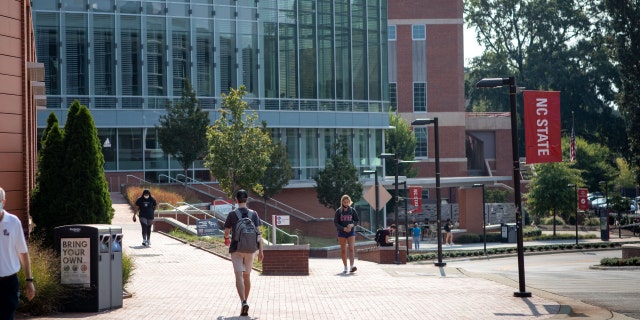This story discusses suicide. If you or someone you know is having thoughts of suicide, please contact the Suicide & Crisis Lifeline at 988 or 1-800-273-TALK (8255).
As the nation grapples with increasing youth mental health concerns, North Carolina State University confronted its own crisis on campus this year.
NCSU recorded a total of 14 student deaths, seven of which were suicides, over the course of the 2022-2023 school year before spring graduation earlier this month. Two students died by suicide over a 24-hour period about a week before commencement.
“This is heartbreaking, and I know there’s little I can say to console the deep hurt or heal the immense grief felt by the family and friends of these young people and others we’ve lost this year,” Chancellor Randy Woodson said in an April 27 statement. “What I can say is that I, along with so many caring members of our community, share in this grief.”
The remainder of the 14 student deaths consisted of two overdoses, four natural deaths and one car accident, the school told Fox News Digital.
SOUTH CAROLINA LAWMAKER EXPOSES DANGERS OF ‘SEXTORTION’ AFTER TEENAGE SON’S SUICIDE
North Carolina State University confronted a crisis during the 2022-2023 school year, during which it reported 14 student deaths, seven of which were suicides. (Sarah L. Voisin/The Washington Post)
“This has been a very difficult time for our university community as we’ve experienced the tragic deaths of several students,” NCSU told Fox News Digital in a statement. “These losses are heartbreaking, especially for the family and friends of the young people we lost over the year. NC State remains committed to strengthening our network of support and resources – especially for our students – and taking action wherever we can to best support our students, faculty and staff.”
WARNING SIGNS OF SUICIDE: WHAT TO KNOW ABOUT PREVENTION, RED FLAGS AND HOW TO DEAL WITH THE ISSUE
The school offers various suicide prevention resources, including a Student Mental Health Task Force that launched in November, an online suicide prevention portal with links to school support programs and information, a crisis hotline and counseling center, a teletherapy service and more.

Robin Glenn, a licensed therapist working primarily with young adults and children, told Fox News Digital that oftentimes, making services and programs available to students is not enough; schools need to require them. (Logan Cyrus/Bloomberg)
However, Robin Glenn, a licensed therapist working primarily with young adults and children, told Fox News Digital that oftentimes, making services and programs available to students is not enough; schools need to require them.
“The last thing a student’s going to do when they’re dark is reach out for resources.”
“Resources have to come to the students. It needs to be a baked-in program that requires attendance on a daily basis.”
Even if schools require a 15-minute class or meeting time for students to gather and talk to one another, such a program can make students feel less alone, she said.
Glenn recommended that teachers come to students rather than the other way around, with required webinars, check-ins, dorm gatherings, or freshman orientation courses addressing resiliency, healthy lifestyles and how to combat loneliness.

Cheerleaders of the North Carolina State Wolfpack wave flags following a touchdown against the Troy Trojans at Carter-Finley Stadium on Sept. 5, 2015 in Raleigh, North Carolina. (Lance King/Getty Images)
Resident Advisor Gustavo Armas shared a similar thought with NCSU’s student newspaper, The Technician.
“They have been trying to offer a lot more events for the community for people to gather, to take a break, even if it’s just a pizza party or anything like that,” Armas told the newspaper. “I know that after what happened this school year, the school in general has been implementing a lot of mental health support and multiple resources, but … they have not met the supply for the demand of students that need the support that they’re asking for.”
Glenn said more than half of college students meet the “criteria for experiencing loneliness.”
“Each year, we’re looking at real depression, not just depressive symptoms.”
“We’re looking at real anxiety, not just anxious symptoms. And so, we’re looking into a lot more of diagnostic criteria than we ever have before. And that’s just increasing year over year,” she said.
While the number of students who have died this year comes as a shock to the Raleigh-based university‘s 36,000-student population, it is indicative of what happens when a national crisis hits a smaller community.
North Carolina Gov. Roy Cooper’s office told Fox News Digital in a statement that state leaders must “prioritize mental health” for students.

While the number of students who have died this year comes as a shock to the Raleigh-based university’s 36,000-student population, it’s indicative of what happens when a national crisis hits a smaller community. (Logan Cyrus/Bloomberg)
“Earlier this year, [Cooper] brought state mental health experts together with chancellors to offer support for student mental health on college campuses,” press secretary Sam Chan said. “In February, the governor allocated $7.7 million for mental health programs in state colleges and universities, following an initial $5 million investment in 2021.”
Suicide is the second-leading cause of death for college students as of 2022, according to the American Foundation for Suicide Prevention.
The suicide rate increased 8% among persons ages 15-24 in 2021 after two years of declines between 2019 and 2020. The national suicide rate in 2020 was 36% higher than the suicide rate in 2000 and 56% higher for the 10-24 age group, the Centers for Disease Control and Prevention found.
CDC REPORTS 60% INCREASE IN HIGH SCHOOL GIRLS SERIOUSLY CONSIDERING PLANNING SUICIDE, SADNESS
Mental health issues on college campuses are becoming more common, according to the National Education Association, which reported in March that more college students today are contemplating suicide than ever before.
Glenn named some of the factors contributing to the mental health crisis among college students as isolation caused in part by COVID-19 and social media, harassment and discrimination from peers, and academic pressure. The ever-increasing price of college tuition, too, is a top concern among students, according to a 2023 Gallup-Lumina Foundation report.

Robin Glenn named some of the factors contributing to the mental health crisis among college students as isolation caused in part by COVID-19 and social media, harassment and discrimination from peers, and academic pressure. (Logan Cyrus/Bloomberg)
U.S. Surgeon General Dr. Vivek H. Murthy released an advisory Tuesday warning of the impacts on social media on young people.
“Nearly every teenager in America uses social media, and yet, we do not have enough evidence to conclude that it is sufficiently safe for them, especially at such a vulnerable stage of brain, emotional, and social development,” Murthy wrote. “Much of the evidence we do have indicates that there is enough reason to be deeply concerned about the risk of harm social media poses. For example, adolescents who spend >3 hours per day on social media face double the risk of developing symptoms of depression and anxiety.”
Murthy added that “children have become unknowing participants in a decades-long experiment.”
Glenn suggested that children and adolescents are “going to have to go through some serious neuro-plasticity as they develop and … unwind that, create new pathways, stop some of those existing ones.”
Apps like TikTok, she said, are “so counterproductive for development.”
Additionally, “contagion” can be a significant factor in youth suicides, according to Glenn, who explained the tragic phenomenon as the “period of time in which other kids are likely to follow suit” after a suicide or other traumatic event.
CLICK HERE TO GET THE FOX NEWS APP
“As a society as a whole, we’re really lacking in resilience, where there’s so much pain and a lot of these kids, and they’re not focusing on how to build these resources up for themselves,” Glenn said. “… It’s just a confluence of factors that are exacerbating issues.”
Glenn recommended young people who feel isolated get out of their rooms and outside, get off their phones and engage in in-person activities such as sports and extracurriculars, clubs and other social events.
Anyone experiencing a mental health crisis can call the National Suicide Prevention Lifeline at 988.